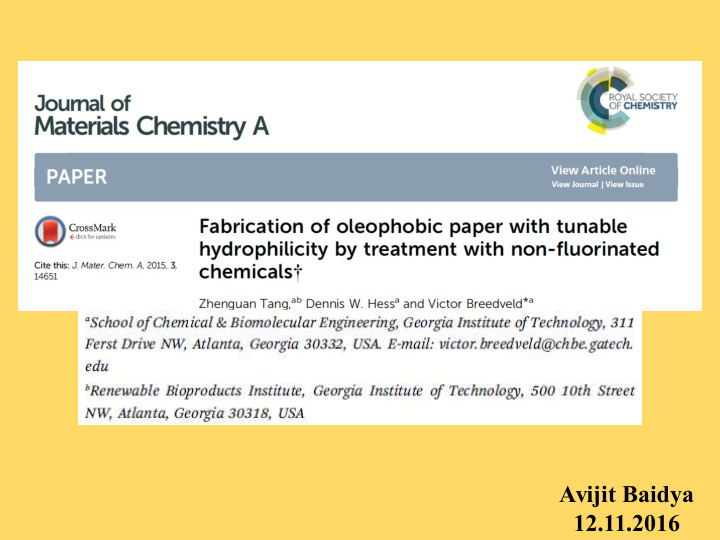



Avijit Baidya 12.11.2016
What is superhydrophobicity ? How it is defined? What is oleophobicity?
Introduction : Hydrophobic and amphiphobic surfaces have been studied in great depth over the past couple of decades for numerous potential applications. Hydrophilicity and oleophobicity have potential use in industrial applications, like oil– water separation membranes, self-cleaning surfaces and anti-fog surfaces. Due to the difference in surface tension between water and oil, fabrication of such surfaces has proven to be much more challenging than hydrophobic or amphiphobic surfaces. The wetting behavior of a liquid drop on a smooth, chemically homogeneous surface is governed by Young's equation, which predicts the magnitude of contact angle based on a force balance that includes the solid surface energy, liquid surface tension and adhesive forces at the solid–liquid interface. On chemically homogeneous rough, structured substrates, Young's equation must be modified (e.g. Cassie–Baxter or Wenzel models ) but these trends still hold. Oleophobic substrates are inherently hydrophobic. But by chemical heterogeneity one can introduce favorable interactions with polar liquids, while maintaining unfavorable interactions with nonpolar liquids.
In this paper: For the first time oleophobic paper with tunable hydrophilicity achieved by using a nonfluorinated material. By changing the MTMS (methyltrimethoxysilane) hydrolysis time prior to coating, different degrees of condensation were achieved. MTMS (methyltrimethoxysilane) has many advantages: lower environmental impact, commercial availability, and compatibility with aqueous processing environments. The MTMS coating process is carried out in an aqueous environment under ambient conditions at a relatively fast rate.
Preparation: MTMS hydrolysis procedure Methyltrimethoxysilane (MTMS) was mixed with 0.1 M hydrochloric acid (HCl, 37.3%) in a 4 : 1 v/v ratio. The mixture was then sonicated in an ice-bath for different lengths of time to induce hydrolysis. MTMS coating procedure Silicon wafers and glass slides served as substrates for MTMS films. These were rinsed with acetone, methanol and isopropanol. Rinsed substrates were subsequently exposed to an air plasma for 5 minutes to remove any solvent residues and ensure the presence of hydroxyl groups on the surface. Cleaned substrates were immersed in the hydrolyzed MTMS solutions for 2 minutes. Control samples were also fabricated by immersing the cleaned substrates in pure, unhydrolyzed MTMS. Coated substrates were then dried at ambient conditions overnight.
Result & discussion: XPS data for Si 2p on silicon wafers coated 29 Si NMR spectra after different hydrolysis with MTMS after different hydrolysis times for acid catalyzed MTMS. times. Peaks in the 95–110 eV range correspond to the 2p1/2 and 2p3/2 peaks of Chemical shifts of -39.1 ppm, -47.6 pm, -57.2 Si. ppm and -66.2 ppm can be assigned to MTMS This gradual shift is likely due to a change in monomer, dimer, linear oligomers and branched oligomers. Peaks at -56.5 ppm and -64.3 ppm MTMS species from dimers to linear are assigned to 4- membered ring and caged polymers and branched polymers. species
ATR-FTIR of (a) MTMS coated glass slides and (b) MTMS coated HSs after different MTMS hydrolysis times. Coated with 5 minutes hydrolyzed MTMS shows strong peaks at 1100 cm -1 , which correspond to Si–O–Si bonds, indicating that MTMS has been successfully grafted onto the substrate surface. Due to the relatively short hydrolysis time, large amounts of MTMS dimers and linear oligomers are still present in the mixture. Both of these species contain silanol groups, resulting in peaks at 890 cm -1 and 3300 cm -1 from Si– OH and O–H bonding.
Properties: Contact angle measurement of water, diiodomethane and motor oil on silicon wafers coated with MTMS after different hydrolysis times.
Contact angle measurements of ethylene glycol on silicon wafers coated with MTMS hydrolyzed for different times as a function of elapsed time after droplet placement. Contact angle measurements of (a) motor oil and (b) water on HSs coated with MTMS hydrolyzed for different times as a function of elapsed time.
Low magnification SEM images of uncoated HSs, HSs coated with 5 min hydrolyzed MTMS and HSs coated with 180 min hydrolyzed MTMS are shown in (a–c), demonstrating that the porosity of native paper is largely retained after coating. Complementary high magnification SEM images are presented in (d–f). Profilometer images for each sample are also presented in (g–i).
Conclusion One-step solution coating method to fabricate oleophobic paper substrates with tunable hydrophilicity using non-fluorinated coating material. The hydrophilicity of MTMS coatings can be tuned by simply adjusting hydrolysis time. MTMS coatings can easily be applied on more heterogeneous, porous substrates such as paper. This material does not contain fluorine and is therefore more environmental friendly than those previously reported. The porous structure of paper is also largely retained after coating. The MTMS coating process is carried out in an aqueous environment under ambient conditions at a relatively fast rate.
how two/ three layers of water molecules in micro droplets are interacting with surfaces having different surface energy? Can we measure the force that droplets are facing when they interacting with different surfaces having different energy? What is the parameter which converts this molecular interaction to macroscopic change in meniscus?
Recommend
More recommend